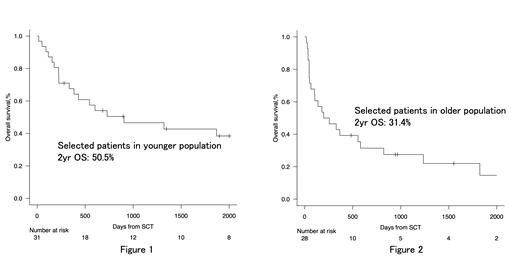Background: Hematopoietic malignancies that relapse after allogeneic stem cell transplantation (allo-SCT) generally have a poor prognosis, and there is no standard treatment. Second allo-SCT is a potentially curative treatment, but many patients do not receive 2nd allo-SCT at the best time because of the long preparation time for transplantation, and even if they do, treatment-related complications and relapse of the underlying disease often lead them to fatal outcomes. Umbilical cord blood is considered to be a promising source of 2nd allo-SCT because of its short preparation time, rapid and high graft-versus Leukemia (GVL) effect after transplantation, and better response to GVHD treatment compared to other donor sources. Therefore, we investigated the usefulness of cord blood transplantation for relapsed hematopoietic malignancies after allo-SCT.
Methods: We retrospectively analyzed the outcomes of patients with hematopoietic malignancies who received single cord blood transplantation (CBT) as 2nd allo-SCT for relapse after allo-SCT in Toranomon Hospital between Apr. 1999 and Mar. 2022. We exclude the patients with Eastern Cooperative Oncology Group (ECOG) performance status(PS) of 4.
Results: 263 patients were included in this study. There were 179 patients with myeloid neoplasms and 84 with lymphoid neoplasms. Median age was 45 years (range: 18-71). 239 patients were in non-remission and 24 in remission before SCT. Median interval between 1st SCT and 2nd SCT was 293 days (26-4703). Donor sources of 1st allo-SCT were related donor in 80, unrelated donor in 62, and sCBT in 121 patients. 135 patients received myeloablative conditioning for 2nd allo-SCT, and 128 patients underwent reduced intensity-conditioning. About cord blood as the donor source of 2nd allo-SCT, the median total nucleated cell count at cryopreservation was 2.71(×10 7)/kg (1.67-5.85), and median CD34 + cell count at cryopreservation was 0.97(×10 5)/kg (0.25-3.18). Median observation period of survivors was 1726 (122-6286) days after 2nd allo-SCT. Overall survival (OS), non-relapse mortality and relapse at 2-year were 16.7%, 46.9% and 40.6%, respectively. Younger patients (< 50 years) had significantly better OS than older patients (50 years and more), with 2-year OS of 21.5% and 9.9%, respectively (P < 0.001). Patients with good PS (0 and 1) had significantly better survival than those with poor PS(2 and 3), with 2-year OS of 23.4% and 2.4%, respectively (P<0.001). Patients with myeloid malignancies tended to have better survival than those with lymphoid malignancies, with 2-year survival rates of 19.2% and 11.9%, respectively (P=0.341). Patients with longer interval between SCTs (>1 year) had significantly better survival than those with shorter interval (<1 year), with 2-year OS of 23.6% and 11.6%, respectively (P=0.00443). In multivariate analysis, younger age (<50), good PS (0-1), long interval between SCTs(≧1 year) showed a superior OS. In the younger age population, patients with myeloid neoplasms showed a superior OS compared to those with lymphoid neoplasms (2yrOS: 30.3% vs 10.6%, P=0.00318). Furthermore, patients with myeloid neoplasms having good PS and long interval between SCTs showed an extremely high survival rate of 50.5% at 2 years (n=31)(Figure 1). In the elderly population, patients with long interval and good PS showed a relatively good OS of 31.4% at 2 years (n=28)(Figure 2). The type of disease (myeloid vs lymphoid) didn't have a significant influence on OS in this subpopulation (28.1% vs 50.0%, P=0.129).
Conclusion: Although the outcomes of CBT as 2nd allo-SCT haven't been satisfactory, there are certain populations, including elderly patients, with favorable OS.
Disclosures
No relevant conflicts of interest to declare.


This feature is available to Subscribers Only
Sign In or Create an Account Close Modal